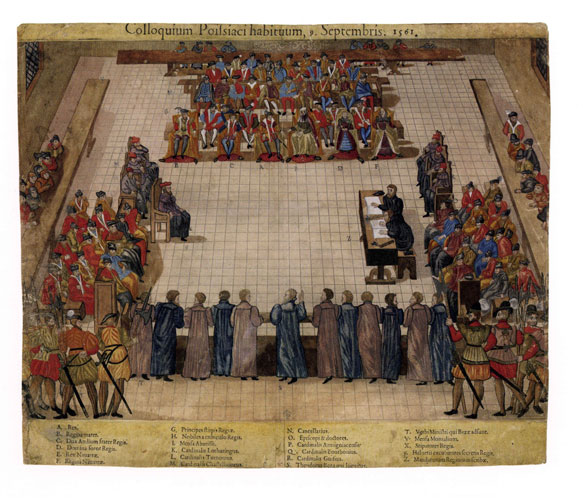Illuminated etching, hand coloured with transparent washes and bodycolours. Around 1570. Size of sheet: 36.7 x 43.4 cm. R.-D. vol. VI. 10 (tres rare). R.-D. 11 (b./ f.). Nagler (Tortorel) 10 Ia. & V. (sehr selten). Adhémar (I.F.F., 1971) 8. (1er pl.) II.
Nagler first and Robert Dumesnil second state with the Latin text.
The prints with the French and the Latin text were published at the same time. The letters and the text above and below are woodcut letter blocks. The legend is printed on the paper margins. The German and Italian text followed later, and woodblock copies were issued when the copper plates were worn down.
There exists also a later second etched version (plate size: 49.2 x 31.6 cm). See an exemple in the British Museum (BM 1855.4.14.188). For a detailed description, see Nagler 10 (‘Auf dem früheren Blatt zeigt die Draperie über dem Tische der Aebtissin Laubwerk statt Blumen, und statt des Monogrammes liest man in der Mitte unten: J tortorel. fecit. Die Erklärung ist gestochen und nicht aufgedruckt.”)
A fresh lifetime fully illuminated impression. The print is slightly trimmed into the image and into the text, but without any loss of text.
There are only a few illuminated impressions mentioned, but none has been published. The excellent publication by Susan Dackerman, Painted Prints, The Revelation of color, The Baltimore Museum of Art, 2002 and The French Renaissance in Prints. From the Bibliothèque Nationale de France, Los Angeles, New York, Paris, 1994/95 could not trace an illuminated impression.
“Jean Perrissin, a Lyon painter, architect, and printmaker, participated in all of the royal entries into Lyon from 1566 to 1608. He is especially famous for the series of prints executed in Geneva and published under the title ‘Histoires diverses qui sont mémorables touchant les guerres, massacres et troubles, advenues en France en ces dernières années (Diverse stories that are memorable concerning the wars, massacres, and unrest occurring in France in these last few years). Jacques Le Challeaux was to have executed them from designs furnished by Nicolas Castellin. The contract was finally signed on July 23, 1569; Perrissin was to engrave on copper the forty large plates of the collection (forty-two with the frontispiece and the note to readers). He was assisted by the Lyon painter and printmaker Jacques Tortorel, who was perhaps ”Jaques the carver of histoires” documented in Lyon in 1557 and again between 1569 – 1575.“
(Marianne Grivel, in: The French Renaissance in Prints. From the Bibliothèque Nationale de France, Los Angeles, New York, Paris, 1994/95, p. 411).
The Colloquy of Poissy, 9 December 1561 was initiated by Catherine de’ Medici - who acted as regent during her son’s minority - in order to find a way to mend the differences between Catholics and Protestants, and to avoid a civil war. In the presence of King Charles IX, Catherine de' Medici, and the King and Queen of Navarre, Clergymen and theologians from both side gathered together in a convent at Poissy. Each side was invited to present their positions, which proved irreconcilable. Overt hostilities between Catholics and Protestants began in March 1562, starting a war that only ended with Henri IV’s accession to the throne in 1584.
Our print was already in the 19th century known as a rarity and as a handcoloured impression even more so. These prints are the earliest examples of popular print production in France.
